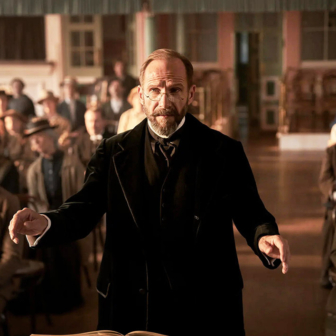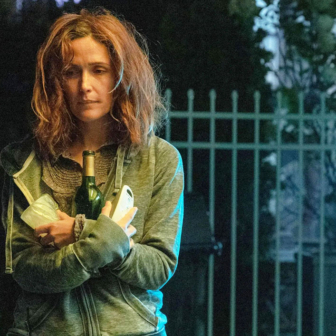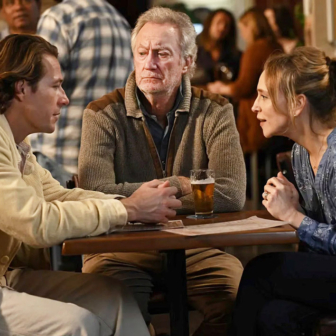In 2021, David Cronenberg released the briefest of short works, made with his daughter Cressida. The Death of David Cronenberg featured the director contemplating a realistic prosthetic corpse laid out in a bed, a body that just happens to be his double. He then climbs into bed alongside his dead self, embracing it with tenderness, a man seemingly in touch with the prospect of his own mortality.
The prosthetic corpse was originally made by the special effects team on a TV series in which Cronenberg had an acting role; he played a wealthy patriarch who ends up dead in a freezer. In The Shrouds, his new feature as both writer and director, this body reappears fleetingly in the background of a scene in a cemetery. There’s something just right about this small act of recycling: pragmatic, personal, a playful element in a potentially dark moment, one of several examples in a film in which Cronenberg explores what we make of corporeal images of every kind.
His singular body of work, over the course of more than fifty years, is a remarkable combination of the visceral and the analytical, the material and the immaterial. The body itself — desiring, decaying, mutating, transforming — has been a source of fascination for Cronenberg in everything from The Brood (1979) to The Fly (1986) to Crash (1996) to Crimes of the Future (2022).
When it comes to The Shrouds, Cronenberg has talked about the 2017 death of his wife of forty-three years, Carolyn Zeifman, as a catalyst for its creation. The film is a portrait of grief as a tactile, tangible thing: painful, messy, unexpected, comic and deeply felt, but as unsentimentally portrayed as you would expect.
In The Shrouds, Vincent Cassel plays Karsh Relikh, an entrepreneur with a new, unusual and expanding business. He owns a cemetery equipped with a system called GraveTech that allows mourners to monitor the body’s slow decay in hi-res detail. Each corpse is wrapped in a proprietary shroud, an enveloping garment equipped with micro-cameras that can be activated to appear on a screen on the gravestone. Karsh’s wife, Becca, who died four years earlier, is buried in the cemetery. He has created this wired mausoleum because of her. The grave is no longer a fine and private place.
Things are not going smoothly, however, for this admittedly specialised service. There are incidents of vandalism and sabotage, and bewildering issues with the condition of some bodies. There is concern that his IT system might be hijacked for illicit surveillance by unknown parties. There is also the matter of Karsh’s unresolved grief, which expresses itself in a range of ways.
One of them, it seems, might be dental decay. Early in the film, his dentist tells him, after a routine examination. “Grief is rotting your teeth.” They register emotion, they react, he insists. And, as it happens, Karsh has been hallucinating in the chair, seeing what turns out to be a vision of Becca’s dead body. The dentist then offers him jpegs of his late wife’s dental records — but even for Karsh, that’s a bit much.
The Shrouds is a chamber piece, and there are times when it feels like much of it is happening inside its characters’ heads. Its references are wide-ranging, its scope expansive, but its cast of characters is small and its mysteries fold in on one another even as they expand. Budget constraints might be part of this, but it also seems to suit the nature of the work.
Becca (Diane Kruger) is present in the film in several ways. She appears to Karsh in dreams or visions, bearing the scars of surgical interventions and treatment. There is something characteristically unflinching about the way Cronenberg invokes her recollected, eroticised, vulnerable body. Who she is, and how she is remembered, becomes part of the narrative, as evidence of a past relationship begins to unsettle Karsh.
She is represented, in a sense, by her sister Terry (also played by Kruger), who closely resembles her. Terry, warm and assured, is a confidante and sounding board for Karsh.
Terry’s ex-husband Maury (Guy Pearce) is an IT expert who has set up GraveTech’s system as well as Karsh’s digital assistant, Hunny; her cartoonish avatar is a young woman, also voiced by Kruger, who bears some resemblance to the sisters. The divorce was six years ago, but Maury, an edgy, needy figure, is not over it: he thinks that he and the widowed Karsh are “brothers in sorrow.”
This is Cassel’s third film with Cronenberg. In the London-set Eastern Promises (2007) he was a Russian gangster; in A Dangerous Method (2011), a period drama about Freud and Jung, he was one of Freud’s most brilliant, erratic patients. In The Shrouds, he’s a more tightly wound, introspective figure, with drawn features and a shock of grey hair: he resembles Cronenberg himself (although he is more than twenty years younger).
The Shrouds takes place in a kind of future-present, a recognisable now with a few twists. Cronenberg’s work regularly includes the notion or operation of conspiracy — often in terms that do not necessarily clarify the nature of the threat, the scheme or intrigue, or even its very existence.
Here, the multiple intrigues and puzzles they take in potential corporate malfeasance, environmental activism, personal vendettas, medical malpractice, international espionage and the fact that a character is sexually aroused by conspiracy. Technology is unreliable, as are people we are close to; what we see is not necessarily what we get, and what we imagine or dream or hallucinate might have more to tell us.
But conspiracies aren’t really the point here. Cronenberg is no stranger to open endings, and there is an unresolved element to The Shrouds that might relate in part to its origins. It was originally to be a Netflix series, but the project was cancelled after a couple of episodes had been written. The feature version doesn’t wrap up neatly, which seems entirely appropriate to what has gone before, both in the film itself and in Cronenberg’s approach to filmmaking. With all that his work has to offer, the last thing we need is closure. •




